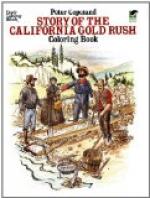Such high prices were paid for these oranges at first, that orange growing boomed all over Southern California. People thought their fortunes were made when they set out a few acres of small budded trees they had paid a dollar or more apiece for. Whole towns sprang up in dry treeless valleys where only cattle and sheep had pastured, and land worth only twenty-five dollars an acre before the orange excitement, sold quickly for eight hundred and a thousand when planted with trees. The towns of Pomona, Redlands, Monrovia, and others in the orange localities were unknown before 1885, and grew to several thousand population in a few years. Everybody talked of the great profit in orange growing, and people who had nurseries of young trees grown from navel buds made fortunes.
At this day thousands of acres of seedless oranges are in full bearing and no one buys the old kinds. Hundreds of car-loads of the seedlings are not even picked, and ninety per cent of the eighteen thousand car-loads which make the season’s orange crop are navel oranges. Over forty-five millions of dollars are now invested in the growing and marketing of this remarkable fruit.
At Riverside, the home of the orange, the two original Washington navel trees still stand. Mr. Tibbets guarded them for years, had them fenced with high latticework, and seldom allowed any one to touch them. He refused ten thousand dollars for them, since for months he sold hundreds of dollars’ worth of buds from these parent trees. These two trees and their large family have caused thousands of people to come to the state, and have built up Southern California wonderfully.
THE LEMON
For many years people who use that sour but necessary fruit, the lemon, thought that only the little yellow ones which came from the far-away island of Sicily were good. The men who import foreign fruits always said so; and in spite of the fact that the larger California lemon was more acid, of as good flavor, smooth skinned, and golden, people believed the Mediterranean groves produced the best. But, at last, our warm, dry air, good soil, and plenty of water, together with care and skill while growing and packing, have made California lemons the most in demand. These lemons keep well, and bear shipping and long journeys better than the imported fruit.
Citrus fruits, as the orange and lemon are called, do well in all the southern counties, and San Diego County boasts of not only the largest lemon grove in California, but in the world. This is a thousand-acre tract overlooking San Diego Bay and cultivated by the Chula Vista colony. It was once a pasture given up to wandering bands of cattle and sheep. There was little water, and no one ever thought these dry mesa lands would one day be a beautiful garden spot, green with the shining lemon leaves, and golden with fruit.




